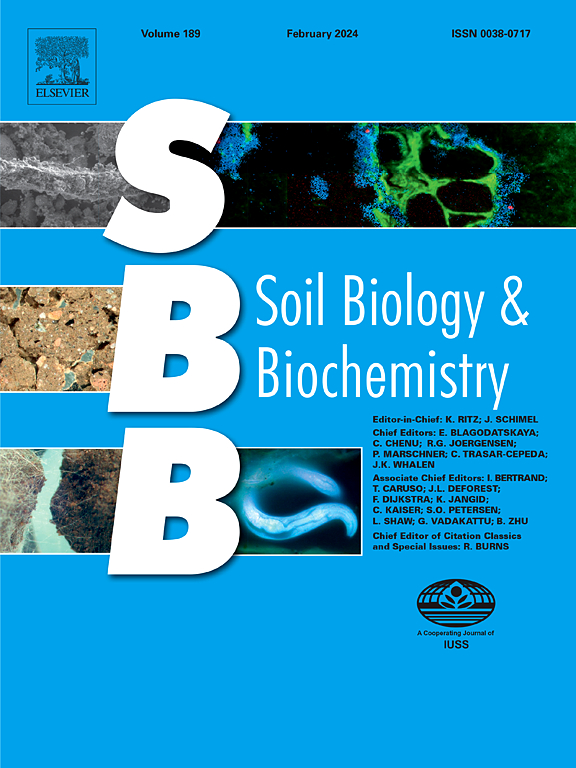Spatiotemporal dynamics of reactive oxygen species in the detritusphere and their critical roles in organic carbon mineralisation
IF 10.3
1区 农林科学
Q1 SOIL SCIENCE
引用次数: 0
Abstract
Reactive oxygen species (ROS) are recognised as important drivers of biogeochemical processes. However, the dynamics and distribution of ROS and their effects on carbon emissions in the detritusphere remain elusive. Herein, we visualised the production of ROS in situ (i.e. superoxide radical, O2•−; hydrogen peroxide, H2O2; and hydroxyl radical, •OH) in the detritusphere using a ROS-trapping agar gel, of which the contents gradually increased and then decreased with residue decay. Spatially, O2•− content gradually decreased with increasing distance from residue, whereas H2O2 content increased. Interestingly, the content of •OH increased from 3.2 to 4.3 μmol kg−1 and decreased from 6.9 to 3.9 μmol kg−1 with increasing distance from residue after incubation for 3 d and 24 d, respectively. Spearman correlation analysis revealed that O2•−production was closely related to the oxidation of water-soluble phenols by phenol oxidase. In contrast, H2O2 production correlated with microbial abundance, suggesting that microorganisms served as primary drivers of H2O2 production in the detritusphere. Results from incubation experiment suggest that the dominant drivers of •OH production shifted from Fe(II) to water-extractable organic carbon (WEOC) between day 3 and day 24 of residue decomposition. Furthermore, autoclaving reduced •OH content regardless of Fe(II) or WEOC presence, highlighting the important role of microorganism in •OH generation. The formed ROS significantly influenced the mineralisation of organic carbon (OC, P < 0.05), and the contributions varied by type of ROS. Specifically, ROS quenching experiments showed that •OH and O2•− stimulated OC mineralisation by 15% and 4%, respectively, while H2O2 reduced it by 18%. The obtained information highlights detritusphere as pervasive yet previously underestimated hotspots for ROS production, which has significant implication for soil OC mineralisation and priming effect.


碎屑层中活性氧的时空动态及其在有机碳矿化中的关键作用
活性氧(ROS)被认为是生物地球化学过程的重要驱动力。然而,活性氧的动态和分布及其对碎屑层碳排放的影响仍然难以捉摸。在此,我们可视化了原位ROS的产生(即超氧自由基,O2•−;过氧化氢,H2O2;和羟基自由基(•OH),随着残渣的腐烂,其含量先增加后减少。从空间上看,O2•−含量随着离残渣距离的增加而逐渐降低,而H2O2含量则逐渐增加。培养3 d和24 d后,随着离残基距离的增加,•OH含量分别从3.2 μmol kg-1上升到4.3 μmol kg-1,从6.9 μmol kg-1下降到3.9 μmol kg-1。Spearman相关分析表明,O2•−的产生与酚氧化酶对水溶性酚的氧化密切相关。相比之下,H2O2产量与微生物丰度相关,表明微生物是碎屑层中H2O2产量的主要驱动因素。孵育实验结果表明,在残渣分解的第3天至第24天之间,•OH生成的主要驱动因素从Fe(II)转变为水萃取有机碳(WEOC)。此外,无论是否存在Fe(II)或WEOC,高压灭菌都降低了•OH含量,这突出了微生物在•OH生成中的重要作用。形成的活性氧显著影响有机碳矿化(OC, P <;0.05),不同类型活性氧的贡献不同。具体来说,ROS猝灭实验表明,•OH和O2•−分别刺激了15%和4%的OC矿化,而H2O2则减少了18%。获得的信息强调碎屑层是普遍存在的,但以前被低估的ROS生产热点,这对土壤OC矿化和启动效应具有重要意义。
本文章由计算机程序翻译,如有差异,请以英文原文为准。
求助全文
约1分钟内获得全文
求助全文
来源期刊

Soil Biology & Biochemistry
农林科学-土壤科学
CiteScore
16.90
自引率
9.30%
发文量
312
审稿时长
49 days
期刊介绍:
Soil Biology & Biochemistry publishes original research articles of international significance focusing on biological processes in soil and their applications to soil and environmental quality. Major topics include the ecology and biochemical processes of soil organisms, their effects on the environment, and interactions with plants. The journal also welcomes state-of-the-art reviews and discussions on contemporary research in soil biology and biochemistry.
 求助内容:
求助内容: 应助结果提醒方式:
应助结果提醒方式:


